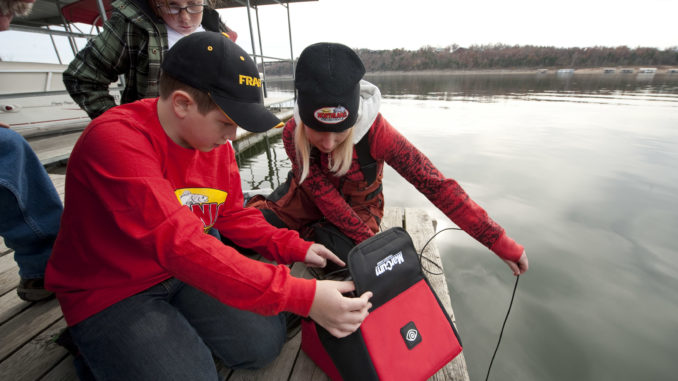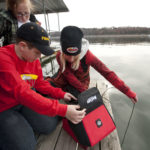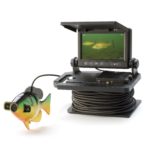
Cameras have come a long way
Underwater video cameras have been around for decades without gaining the popularity they deserve. They have always delivered decent picture detail, but the older cathode ray tube (CRT) screens used by earlier models suffered visibility problems from glare and grayed out in bright sunlight. Bulky cables and camera heads were difficult to manage, and the systems had a heavy thirst for battery power.
Despite their drawbacks, fishermen used them to positively identify the species and size of fish they spotted on their sonar screens.
Cameras have always made great teaching tools, and parents dropped cameras over the side to let kids and grandkids watch life unfold under docks and under boats anchored in open water or tied up in marinas. Folks who dropped their prescription eyeglasses or other valuables off a dock could find them with a camera, and watch as they retrieved them with a weighted treble hook. Cameras also saw limited use in aiding law enforcement and search and recovery teams to find submerged evidence and locate drowning victims.
The difference between those old video systems and today’s units is absolutely astounding. Perhaps the most amazing new example is the Aqua-Vu Micro Color video system that fits in your pocket. Its full-color monitor is about the size of a smart phone and is equipped with a 3.5-inch LCD display. The camera is about the size of a quarter and is connected by 50 feet of super-thin, 22-pound-test cable that winds up on a spool on the back of the monitor. A built-in lithium-ion battery powers the system for up to six hours before needing to be recharged.
The camera is small enough to look into tight spaces, and it comes with a directional fin that lets you rig it to look straight up and down or sideways. A built-in ambient light sensor automatically turns the camera’s two infrared lights on or off as needed. The system also works above water, and could be used as a backup camera for a vehicle. The Micro Color system comes with a suggested retail price of $299.
One common problem when using an underwater camera has always been figuring out which direction the camera is pointing so you know where fish and other objects that you see on the screen are in relation to the camera. Aqua-Vu’s AV-360 system ($599) with a Quad camera on 60 feet of cable shows views from lenses aimed in all four directions at once in different windows on the same screen. You can literally see everything in a full 360-degree circle around the camera housing. Another method of tracking camera direction is used in other Aqua-Vu models: a small window on the screen displays the camera’s depth, the direction it is pointing and the temperature of the water around the camera.
If you are a stickler for picture quality, the Aqua-Vu 760cz system ($599) features 3X digital zoom and a Sony camera with the biggest sensor in the industry attached to 100 feet of cable. Thanks to the big camera sensor, the 760’s 7-inch, sunlight-viewable screen can show more area, the same amount of area in better detail and it can deliver better picture quality in low light conditions. You can check out these and other Aqua-Vu camera systems at aquavu.com.
MarCum Technologies (marcumtech.com) offers both camera and sonar systems. The company’s flagship camera model is the VS825SD ($699) with a waterproof, 8-inch switchable color/B&W LCD screen. The screen connects to a Sony Super HAD II CCD camera with 75 feet of cable. Displays include camera direction, depth, water temperature and battery voltage. The entry-level unit at the other end of MarCum’s camera line is the VS380 ($279) with 7-inch B&W CRT monitor and 60 feet of cable. MarCum cameras come with the company’s Auto Camera Panner, which rotates the cameras 360 degrees at the touch of a button.
Vexilar, a Minnesota-based company famous for producing ice fishing sonar and camera systems, offers underwater cameras that also work fine down south in fresh or salt water. The company’s Fish Scout 2000DT ($599) also includes a small, on-screen data window displaying the camera’s depth, the compass direction it’s pointing and the temperature of the water around it. Fish Scout units feature a wide, 7-inch color LCD screen fed by a Sony Super HAD CCD camera with 80 feet of cable. The camera switches automatically between color and black-and-white imaging according to available light. The system operates for up to nine hours on a fully-charged battery. You can check out all their camera and sonar products at vexilar.com.
The bottom line
Underwater cameras can add another dimension to your enjoyment on the water. Some come with video-out jacks that let you connect them to recording devices, multi-function displays or even flat-screen TVs.
Most portable camera systems come in weatherproof carrying cases with rechargeable batteries and automatic chargers. Other camera systems mount on your boat and are powered by the boat’s electrical system. Try one and see what you’ve been missing!




